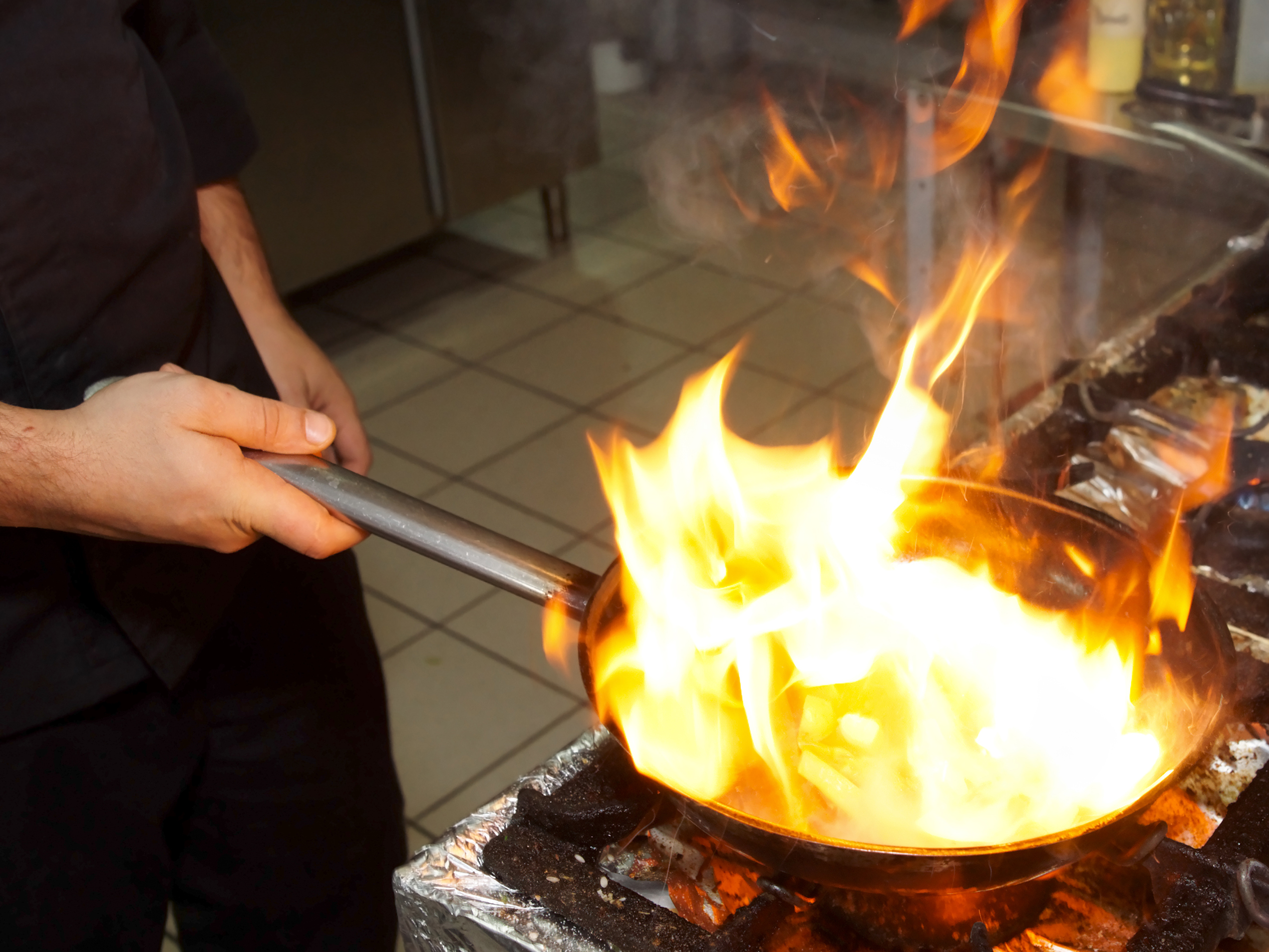- There are some dishes that are commonly set on fire (or flambêed) before they are served.
- From fruity desserts to hunks of meat, a splash of liquor and a flame can add an extra layer of flavor to a dish.
- In many cases, these dishes are flambêed has part of a special, table-side presentation.
- Visit INSIDER’s homepage for more stories.
Although it requires a few safety measures, lighting food on fire could be one of the absolute most exciting ways to cook it.
Using the French-named flambé technique, chefs douse a dish with liquor and then briefly set it alight. Although the liquor taste generally burns off of the dish, it often leaves behind a subtle hint of flavor and golden caramelization.
Here are some dishes that are commonly set ablaze before they’re served.
Cherries Jubilee was supposedly served at a celebration for Queen Victoria’s reign as monarch.

This fruity dish is said to have been created by Auguste Escoffier, a French chef. Supposedly he presented the cherry-based dessert at one of Queen Victoria’s celebratory jubilees.
There have been mixed reports about whether or not this dessert was served at Queen Victoria's golden jubilee (celebrating her 50th year as monarch) or her diamond jubilee (celebrating her 60th year as monarch).
The simple dessert is made by simmering cherries with sugar, water, and butter. Then, it is covered with bourbon or brandy and flambeéd table-side. The dish is often served with vanilla ice cream and sometimes it's used as a topping for cakes.
Flaming shrimp is an easy, yet impressive, dish to make.

Also called shrimp flambé, this dish cooks as the alcohol burns off of the shrimp. Depending on the recipe, it can be made spicy or with a Cajun flair. It is usually flambéed with a bit of cognac, bourbon, or brandy.
Christmas pudding, also known as figgy pudding, is served with a fiery presentation.

Typically consisting of dried fruit and suet (made from the fat surrounding animal kidneys), this pudding is usually coated in a brandy or cognac sauce and set ablaze before it's served.
You might recognize figgy pudding from when it was the fiery centerpiece of Charles Dickens' "A Christmas Carol" or you may be familiar with its mention in the lyrics of the classic holiday song, "We Wish You A Merry Christmas."
Although the ingredients used to make this pudding may vary, it's still common for this English dish to be served at Christmastime.
Bananas foster is a dessert loaded with caramel flavors.

Bananas foster is a dish that consists of bananas, vanilla, butter, cinnamon, banana liqueur, and dark rum. It's usually lit on fire table-side and served with ice cream.
This classic dessert is said to have been invented in 1951 at Brennan's Restaurant in New Orleans, Louisiana. This dish is also supposedly named after Richard Foster, who, at that time, was the chairman of the New Orleans Crime Commission and friend of the owner of Brennan's.
Cheese saganaki is a hot appetizer.

Cheese saganaki is a Greek dish made by lighting aflame a firm cheese, such as sheep's-milk cheese, halloumi, or feta cheese, that's been covered with a bit of liquor, typically brandy. This dish is often flambéed in a table-side performance.
The word "saganaki" refers to the two-handed dish that this appetizer is commonly served in.
Read More: 10 of the best cheeses for snacking and cooking, according to chefs and cheesemongers
Some initially called this dish an "Alaska, Florida."

Baked Alaska usually consists of layers of cake and ice cream that are hidden under a dome of baked meringue. As a final touch, this dish is usually splashed with dark rum and lit on fire in a table-side flambé.
Although it's unclear if it was actually created by him, Charles Ranhofer, a former chef at Delmonico restaurant in NYC, used to popularly serve this dish under the name "Alaska, Florida" in the 1860s.
Per NPR, this name referenced the contrasting temperatures of the dessert. The toasted meringue is warm (a reference to Florida's hot weather) whereas the ice cream inside of the dish is cold (a reference to Alaska's cold weather).
Steak Diane typically involves a flambé technique.

To prepare this impressive steak dish, start by searing and cooking your meat until it's tender. Typically, this dish is splashed with cognac and set ablaze table-side though it isn't always flambéed - it depends on which recipe you follow.
Although its origins are hazy, steak Diane was popularly consumed at restaurants in post-World-War-II New York City. It was considered to be luxurious at the time, likely because of how meat had previously been rationed during wartime.
Crêpes Suzette is a breakfast dish made popular in Parisian restaurants.

This elegant dish typically consists of crêpes paired with a sauce that's made from sugar, orange juice, and triple sec liqueur.
Although the exact origins of this dish are unclear, some reports say the dish was created in the 1910s when Henri Carpentier, who was an assistant waiter at the Cafe de Paris at the time, accidentally set a dish of crêpes and brandy ablaze when serving it to the Prince of Wales (who would later become King Edward VII of England).
